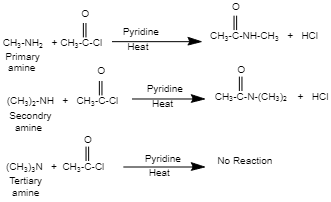
Which of the following compounds cannot be acetylated?
(A) $C{{H}_{3}}N{{H}_{2}}$
(B) ${{(C{{H}_{3}})}_{2}}NH$
(C) ${{(C{{H}_{3}})}_{3}}N$
(D) None of these
Answer
218.7k+ views
Hint: The chemical process of adding an acetyl functional group to a chemical molecule is known as acetylation. When treated with acid chloride, anhydride, or esters, aliphatic and aromatic primary and secondary amines undergo acetylation reactions via nucleophilic substitution. This process occurs in the presence of a strong base like pyridine. When an amine reacts with acid chloride, it releases $HCl$ . This $HCl$ shifts the equilibrium to the right hand side of the reaction.
Complete Step by Step Solution:
For compounds to get acetylated, it is necessary to have $\alpha $ – hydrogen. In this case, methyl amine ($C{{H}_{3}}N{{H}_{2}}$ ), a primary amine, has two -hydrogens, while dimethyl amine (${{(C{{H}_{3}})}_{2}}NH$) , a secondary amine, has one. So, these compounds can be acetylated easily with acid chloride, anhydride, or esters. However, because there is no $\alpha $ -hydrogen attached to $N$ in trimethylamine (${{(C{{H}_{3}})}_{3}}N$ ), a tertiary amine, it cannot be acetylated.
 Correct option: (C) ${{(C{{H}_{3}})}_{3}}N$.
Correct option: (C) ${{(C{{H}_{3}})}_{3}}N$.
Additional Information: The process of amines reacting with benzoyl chloride is known as benzoylation. Deacetylation, which means removing an acetyl group from a chemical compound, can be considered the opposite reaction to acetylation.
Note: The hydrogen attached to nitrogen is analysed and not with carbon as the hydrogen attached to nitrogen gets released in the form of $HCl$ , which shifts the equilibrium to the right hand side of the reaction. So, there should be at least one hydrogen attached to nitrogen in an amine to undergo acetylation.
Complete Step by Step Solution:
For compounds to get acetylated, it is necessary to have $\alpha $ – hydrogen. In this case, methyl amine ($C{{H}_{3}}N{{H}_{2}}$ ), a primary amine, has two -hydrogens, while dimethyl amine (${{(C{{H}_{3}})}_{2}}NH$) , a secondary amine, has one. So, these compounds can be acetylated easily with acid chloride, anhydride, or esters. However, because there is no $\alpha $ -hydrogen attached to $N$ in trimethylamine (${{(C{{H}_{3}})}_{3}}N$ ), a tertiary amine, it cannot be acetylated.
 Correct option: (C) ${{(C{{H}_{3}})}_{3}}N$.
Correct option: (C) ${{(C{{H}_{3}})}_{3}}N$.Additional Information: The process of amines reacting with benzoyl chloride is known as benzoylation. Deacetylation, which means removing an acetyl group from a chemical compound, can be considered the opposite reaction to acetylation.
Note: The hydrogen attached to nitrogen is analysed and not with carbon as the hydrogen attached to nitrogen gets released in the form of $HCl$ , which shifts the equilibrium to the right hand side of the reaction. So, there should be at least one hydrogen attached to nitrogen in an amine to undergo acetylation.
Recently Updated Pages
Is PPh3 a strong ligand class 12 chemistry JEE_Main

Full name of DDT is A 111trichloro22bispchlorophenyl class 12 chemistry JEE_Main

Sodium acetate on heating with soda lime produce A class 12 chemistry JEE_Main

Find the isoelectric point pI of Lysine A 556 B 974 class 12 chemistry JEE_Main

The order of basicity among the following compounds class 12 chemistry JEE_Main

The number of isomers in C4H10O are a7 b8 c6 d5 class 12 chemistry JEE_Main

Trending doubts
JEE Main 2026: Application Form Open, Exam Dates, Syllabus, Eligibility & Question Papers

Derivation of Equation of Trajectory Explained for Students

Hybridisation in Chemistry – Concept, Types & Applications

Understanding the Angle of Deviation in a Prism

Understanding Collisions: Types and Examples for Students

Understanding Atomic Structure for Beginners

Other Pages
NCERT Solutions For Class 12 Chemistry Chapter 1 Solutions - 2025-26

NCERT Solutions for Class 12 Chemistry Chapter Chapter 7 Alcohol Phenol and Ether

NCERT Solutions ForClass 12 Chemistry Chapter Chapter 8 Aldehydes Ketones And Carboxylic Acids

JEE Advanced Marks vs Ranks 2025: Understanding Category-wise Qualifying Marks and Previous Year Cut-offs

Haloalkanes and Haloarenes Class 12 Chemistry Chapter 6 CBSE Notes - 2025-26

Solutions Class 12 Chemistry Chapter 1 CBSE Notes - 2025-26




